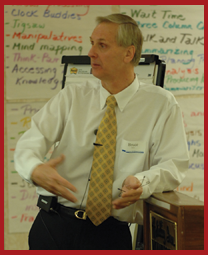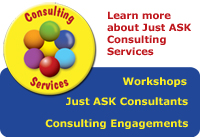
Volume II Issue XII
Share this newsletter on
Closing the Achievement Gap

Bruce facilitating a Leading the Learning® workshop
The most important job that a principal has is to be an instructional leader. As a principal, I always took this responsibility seriously. Although instruction was my priority, there were days that would go by when I did not give much thought to instruction. The urgent took over the important as parent inquiries, student issues, central office demands, far too many phone calls and e-mails, and conversations/problem solving with staff members easily filled my days. When I did have time to focus on instruction, it often seemed that I did not know where or how to start. The educational periodicals remained scattered across my desk, unread books with important ideas piled up, and notes from meetings and workshops sat in nicely labeled file folders. Often the information about instructional ideas went on for pages and pages and I simply could not find the time to wade through the pages to discover the essential information that would be most useful in my school setting.
With each successive year of the No Child Left Behind legislation, the stakes get higher. School leaders are asked to analyze data and respond appropriately in order to improve test scores. School leaders, in turn, place demands on their teachers to show greater results. Often we do not know how to translate the demand for improved student achievement into the necessary actions to get the results we so passionately seek.
Over the past few months, I have wrestled with the idea of instructional leadership at the school level. I continue to read voraciously and to attend workshops. In short, I continue to seek out the answers that make the most sense to me that will make me a better instructional leader. At the forefront of my journey through the maze of instructional ideas has been a continual focus on how to close the achievement gap between those students who continue to make progress as compared to students who are stagnant or not showing growth. I have read educational research, listened to practitioners who have shared their best thinking with me, added a dash of common sense, and reached some conclusions about the “best thinking” to help eliminate the gap between achievers and non-achievers.
Top Ten Tips for Closing the Achievement Gap represents the practical conclusions I have reached about how we can best work together to close the achievement gap. Each of these points could be the focus of a separate faculty or team meeting discussion. I think you will find them quite thought provoking.
Permission is granted for reprinting and distribution of this newsletter for non-commercial use only. Please include the following citation on all copies:
Oliver, Bruce. “Closing the Achievement Gap.” Just for the ASKing! November 2005. Reproduced with permission of Just ASK Publications & Professional Development (Just ASK). © 2006 Just ASK. All rights reserved. Available at www.justaskpublications.com.



